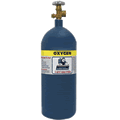|
Gases are characterised by their properties. They have no fixed shape or volume and tend to spread out to fill all the available space. |

|
Kinetic theory of gases
As the particles fly around at high speed, they collide many times per second with each other and with the walls of any container. If the container has no walls, the gas particles spread out to fill all the available space.
To deal with gases in chemistry some assumptions are made:
- 1 The gas particles themselves occupy no volume.
- 2 The forces of attraction between particles are so small as to be negligible.
- 3 Collisions involving gas particles are perfectly elastic.
Gas volume
In chemistry, volumes are usually measured in litres (decimetres cubed, dm3) and centimetres cubed (cm3), rather than metres cubed (m3). The reason for this is purely practical, the metre cubed is a very large volume compared to the test tubes and flasks used in laboratories. See apparatus, section 1.62.
Gas volumes may be quoted in metres cubed (m3), litres (L), centimetres cubed (cm3) or millilitres (mL), depending on the textbook consulted.
1m3 (1 metre cubed) = 1000 dm3 (1000 decimetres cubed) = 1,000,000 cm3 (1 million centimetres cubed)
1 decimetre cubed (1 dm3) is also called 1 litre (= 1000 cm3)
1 centimetre cubed (cm3) is also called 1 millilitre (mL) as it is 1/1000 of a litre.
Conversion between volume units
To convert from cm3 or ml to dm3 or litres divide by 1000
To convert from dm3 or litres to cm3 or ml multiply by 1000
Gas pressure
The pressure of a gas is caused by the gas particles colliding with the walls of the container. Each small collision exerts a force on the wall. The sum of these forces over an area of the wall is called the gas pressure. The SI unit of force is the Newton and the unit for area is the metre squared (m2). Pressure is measured in Newtons per metre squared = Nm-2. This combined unit is called the Pascal, Pa.
The Pascal is a fairly small quantity and atmospheric pressure = 100.0 kPa (approximately) - this is the value used for gas calculations in the IB chemistry exams.
|
Note: In SI units the atmospheric pressure = 100.0 kPa = 1.00 x 105 Pa. Older measurements for pressure may be encountered in textbooks, for example: mmHg (Torr), where atmospheric pressure = 760 mmHg (Torr). However, the IB is fairly consistent with the use of kPa as a pressure measurement. |
|
Conversion of pressure units 1000 Pa = 1 kPa To convert from Pa into kPa divide by 1000 To convert from atm (atmospheres) to kPa multiply by 100 To convert from kPa to atmospheres divide by 100 |
Temperature
The SI unit of temperature is the kelvin (K), although problems are often set in degrees Celsius (ºC). It is important to ALWAYS carry out gas calculations using absolute (kelvin) temperature values.
0K is called absolute zero. It is the temperature at which particles have no energy. This temperature is equal to -273.16ºC, approximated to -273ºC. The magnitude of 1 kelvin is the same as that of 1º Celsius, therefore;
|
Conversion of temperature units To convert from degrees Celsius to Kelvin add 273 To convert from Kelvin to degrees Celsius subtract 273 Absolute temperature in Kelvin = degrees Celsius + 273 Temperature in degrees Celsius = Absolute temperature in Kelvin - 273 |

